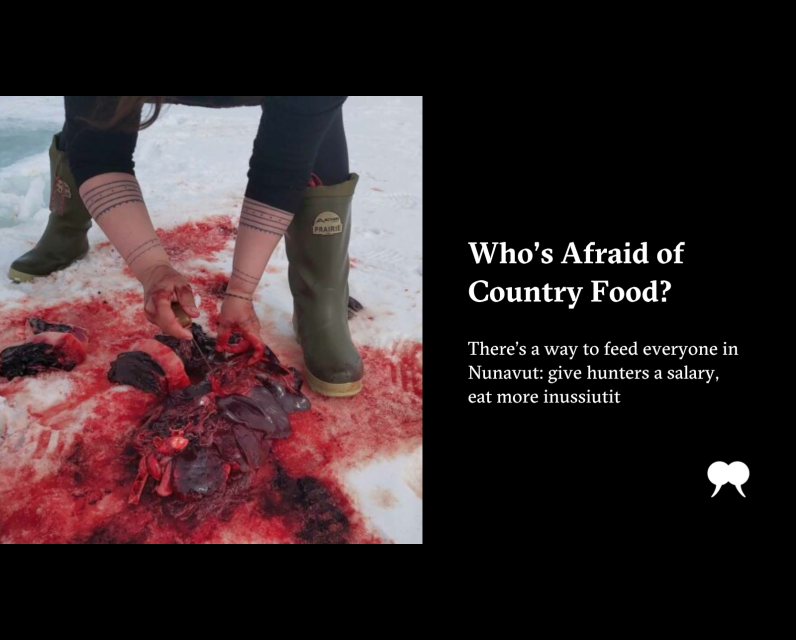Source Feed: Walrus
Author: Laakkuluk Williamson Bathory
Publication Date: September 25, 2024 - 06:30
Who’s Afraid of Country Food?
September 25, 2024

“What ceremony would you like to perform to open the exhibition?”
Inuit have created a modern ceremony that suits Western institutional special occasions and honours Inuit elders: lighting a qulliq—a traditional oil lamp, usually made from soapstone, filled with oil and lit with a long horizontal wick made from the cotton of tundra plants. The practice is soothing and teaches people about the traditional hearth of Inuit households, our source of light and warmth. That’s probably what the gallery representatives were thinking of when they asked the question—or prayers or smudging, along the lines of the practices of other Indigenous cultures.
“We would like to butcher a full seal in Walker Court,” I said. I leaned back from the boardroom table at the Art Gallery of Ontario and made eye contact with my fellow Inuit co-curators, Taqralik Partridge, Jocelyn Piirainen, and Kuzy Curley. We all nodded, and the others affirmed, “Yes, we would like to butcher a seal.”
The four of us had been brought together to create Tunirrusiangit, a retrospective exhibition in 2018 of Kenojuak Ashevak’s and Tim Pitsiulak’s work. It was the biggest Inuit art exhibition the AGO had ever hosted. We wanted everything to be grand, to be a gift, in order to honour these extraordinary artists.
I did not want to hear the details of how impossible all the rules and regulations of the gallery, the City of Toronto, and public health would make it; I am well acquainted with how white institutions abhor non-industrial food practices and, by default, Inuit food systems. Throughout my life, I have watched white people in particular show their distaste for the look, smell, and taste of inussiutit—Inuit cultural food. In the months after I made the suggestion, I know that AGO staff would have liked to have shared all the details of the bureaucratic hurdles with me, but I maintained that it was not my burden to carry, so for me, all I had to do was sharpen my ulu.
Cutting up a seal is simultaneously an elevated and a mundane activity, performed on the shores all around the Arctic every day. It is a spiritual act that connects us viscerally to our ancestors, our environment, and to the animal itself. It is also as normal as picking up milk and eggs at the grocery store. Eating inussiutit that we harvested ourselves gives us great joy, satisfaction, health, groundedness, and self-determination; it is a combination of kinetic and tactile movement, spiritual accordance, and political assertiveness. Serving a full seal on the floor of Toronto’s largest downtown art gallery would concurrently be a celebration of Inuit culture and an act of rebellion against the structural barriers that stigmatize our use of meat.
In Kalaallisut (West Greenlandic), we say “takanna” before a meal, in the same way the French say “bon appétit.” It means “down there.” This is in reference to the traditional way of preparing and eating food—on the ground, or on a clean floor—and also reveres our sea goddess, who resides at the bottom of the ocean. Greenlanders rarely eat on the floor anymore, having taken on the colonial habit of using tables and chairs. Nunavummiut, however, regularly prepare and eat food on the floor. You can walk into any Nunavut building where Inuit are gathered, from offices to school rooms, hotel rooms to everyday kitchens, and find families crouched down, cutting up mattak, iqaluk, nikku, and quaq (whale skin, fish, dried meat, and frozen meat).
Sure enough, about a half year after the first utterance of the idea, a fat, gleaming silver-haired seal lay on the floor of Walker Court, hunted by Mathewsie Ashevak, Kenojuak’s grandson. The court was packed with Torontonians of all backgrounds, some prominent artists along with many Inuit brandishing ulus and knives, excited to share the meat. Most attendees, including AGO staff who came to the occasion on their day off, some with their children, had never seen a seal, dead or alive, let alone partaken in eating one.
“I can’t see what’s happening! Everyone, sit down!” Rebecca Belmore, the empress of Indigenous art, cried out. “Rebecca Belmore said she can’t see! Everyone, sit down!” I shouted, and hundreds of people fluttered to the floor as Kuzy, Mary Pitseolak, a couple other Inuit, and I slit open the seal, exposing the tight coils of intestines and the purple-brown slick of liver. We quickly disjointed the flippers, and the whole crowd cheered as we lifted each one in the air. Within a couple minutes, we had separated the body of the seal from its pelt and began cutting off slices of frozen meat and fat. We filled little bamboo bowls with morsels of meat, and the onlookers passed the vessels around the court until everyone was licking their fingers, their lips glistening with bright red blood. Contented sighs, delighted cries, and ongoing calls for more of the buttery, sweet-tasting meat to be cut reverberated around the room. We cut and cut until only the bones were left. We had eaten the whole animal.
As it turns out, after the event, the City of Toronto sent the AGO a letter of thanks for the things they learned about Inuit cultural practices and how to become a more welcoming space.
The butchered meat and braided intestines from Akutaq’s first seal catch (Akutaq Williamson Bathory)
After you give birth and the baby is breathing and wondrously sucking on your breast and the placenta has come out and your flesh is safely tucked into little stitches and the pain has subsided and waves of love rock your entire being, you become incredibly hungry and thirsty. To think I was once given a large container of frigid river water, procured from under the ice and brought straight to my recovery room by a dear friend! The most immaculate taste travelled from the tip of my tongue to the bottom of my stomach, the cold reverberating through all my hot, exhausted muscles and healing me. I guzzled the entire container. The nurses looked the other way, as the hospital in Iqaluit did not at the time serve any food (or water) from the land.
My husband and I started having babies in the mid aughts, about six years after the establishment of Nunavut as Canada’s newest territory. We were a part of the cohort of freshly educated anaanas and ataatas (mummies and daddies) that filled Nunavut’s offices trying to tackle the still-unrealized task of establishing Inuit self-determination. The young moms among us quickly noticed a major gap in our ability to work: no daycare. We took over a former greasy-spoon restaurant and converted it into Tumikuluit Saipaaqivik, Iqaluit’s first (and so far only) Inuktitut daycare. One fundamental program we established, along with the requirement to speak only our own language to the kids and within the space, was preparing and serving inussiutit on a daily basis to children and staff alike. We wanted the children to develop an early and foundational taste for our food—to make it a part of their normal routine to see their caregivers plucking birds, cutting up meat on the floor, and preparing intestines. We also wanted to provide local hunters with a reliable demand for inussiutit.
When I first presented the program details to a Government of Nunavut daycare regulator, the proposal was immediately turned down, because there was no formal way of ensuring the safety of the meat—there is no authority with official credentials to inspect inussiutit. Instead, hunters use their own training, skills, and assessment criteria to deem their catch safe to eat. At the time, all food served at daycares had to be purchased from stores, where products were regulated at an institutional level. Over the course of a few months, however, the government representative was persuaded by our arguments that one cannot get any fresher, more carefully attended to, and cleaner food than game that is handed to the cook straight from the hunter. It is now permissible for all daycares in Iqaluit to serve inussiutit.
As you land at any airport in Nunavut, you are struck by how tiny each community is in comparison to the vastness of the land and sea surrounding it. The land and sea are full of food. Many people drink directly from rivers in Nunavut, with the exception of streams that go through town and mine sites. And yet 70 percent of Inuit preschoolers—children aged three to five—suffer from food insecurity, meaning they experience hunger in their daily lives. This is institutional poverty.
Currently, though hunting and harvesting have a lot of public reverence in Nunavut, at an institutional level, they are treated as a somewhat subsidized recreational activity. Some workplaces allow people to take harvesting or cultural leave from their day jobs. Otherwise, people use their precious weekends, evenings, annual leave, or leave without pay to go on the land and hunt; basically, a hunter leaves the monetary economy each time they go hunting. The considerable costs of buying or manufacturing equipment—guns, boats, motors, snowmobiles, qamutiit (sleds), clothing, and other tools—are footed by individual families.
Laisa Watsko from Grise Fiord, Joe Amarualik from Resolute Bay, Niore Iqalukjuaq from Arctic Bay, Eric Ootoova from Pond Inlet, and Nina Qillaq from Clyde River are a group of hunters and thinkers spearheading a push across Qikiqtaaluk (Baffin Island) to establish full-time jobs for hunters through a program called Nauttiqsuqtiit (Inuit stewards). It’s supported by funding from Inuit Impact and Benefit Agreements with the federal government. This program reaffirms that Inuit hunters know the land, water, and animals more intimately than any other environmental monitoring effort in the Arctic, and that they have the capacity to address food sovereignty in Inuit communities by harvesting full time.
Nauttiqsuqtiit are fully paid and outfitted to be on the land, maintain their equipment, and train the next generation of hunters. The program is successfully operational in Clyde River, Grise Fiord, Pond Inlet, and Resolute Bay. Qikiqtani Inuit Association, the Inuit organization that manages Nauttiqsuqtiit, is pushing to have the program exist in perpetuity in all Qikiqtani communities. Imagine growing up with the possibility of aspiring to become not just a nurse, a doctor, or an engineer but also a hunter.
Imagine, too, the day when a self-employed Inuk artist does not have to dig her heels in to make the magic of feeding a single seal to many hundreds of people at a Canadian gallery. Imagine when we have the capacity to feed our children our own food so that they all have enough to eat whenever they want to eat. We are making it happen. We are almost there.
Nearly twenty years have passed since we opened Tumikuluit Saipaaqivik. The first graduates of the daycare have finished high school and are achieving many of their adult firsts. Soon enough, they will be the freshly educated anaanas and ataatas filling the offices, dreaming and planning for their revolution.
With thanks to the Gordon Foundation for supporting the work of writers from Canada’s North.The post Who’s Afraid of Country Food? first appeared on The Walrus.
September 25, 2024 - 08:46 | Special to National Post | National Post
Ontario’s education minister has asked for an investigation into a Toronto field trip that saw students involved with a downtown protest.
September 25, 2024 - 08:23 | Aaron D’Andrea | Global News - Ottawa
Ontario’s education minister has asked for an investigation into a Toronto field trip that saw students involved with a downtown protest.
September 25, 2024 - 08:23 | Aaron D’Andrea | Global News - Canada



Comments
Be the first to comment